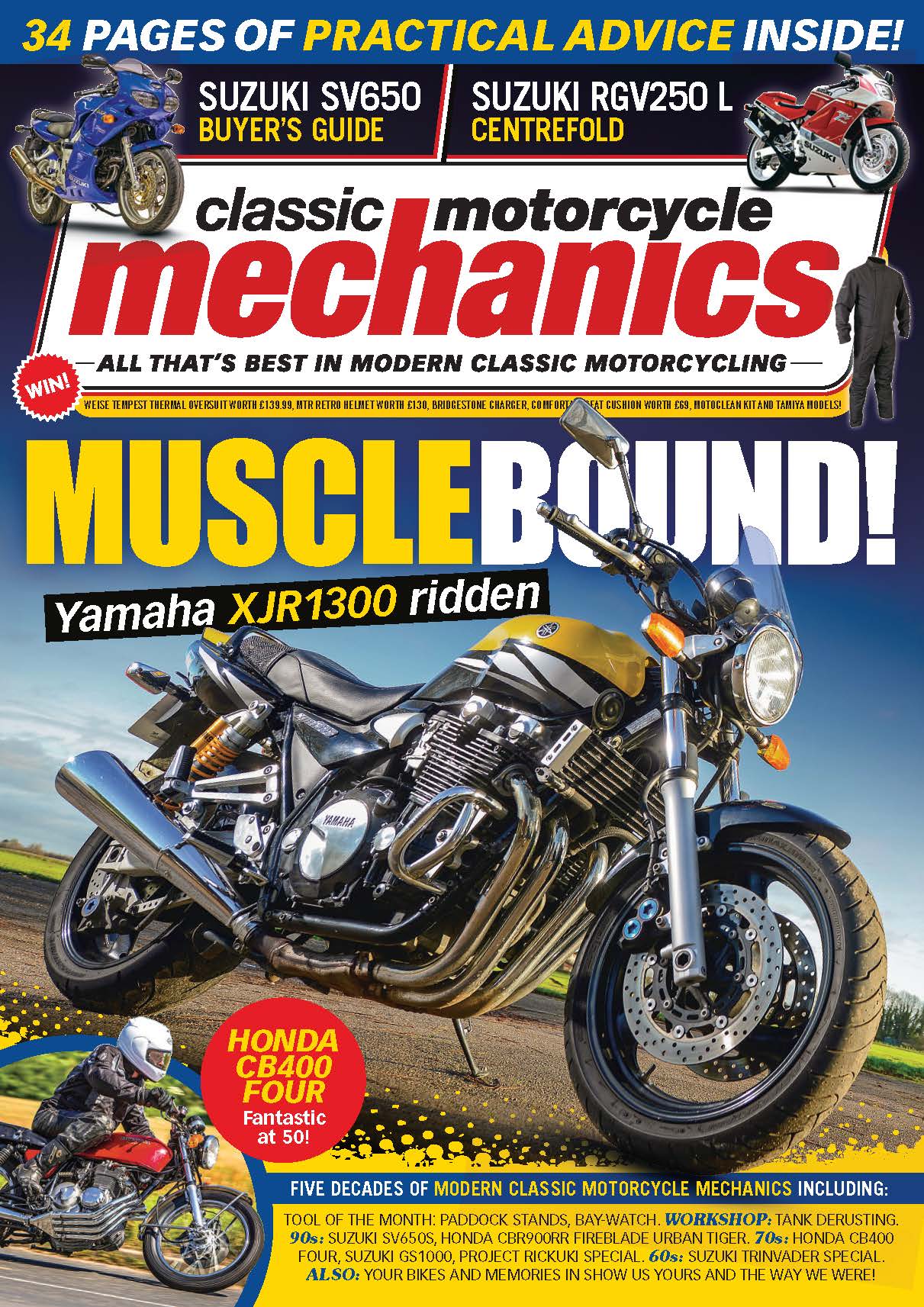If you want a practical and cheap machine that punches above its weight and also gives you the giggles – try a Fazer 600.

Words: Bertie Simmonds Photos: Gary Chapman
Looking back to the 1990s, I can’t help but think what a great decade it was to ride a motorcycle through…
Enjoy more classic motorcycle reading, Click here to subscribe to one of our leading magazines.
I mean, think of it. We had it all back then, with sports bikes in all shapes and sizes. Foggy was beating them all in World Superbikes and (as a
result) we had a wide range of lovely Italian V-twins or copycats thereof.
Bikes were simpler and massively cheaper, sales were on the up thanks to born-again bikers, and the soundtrack to the times was Brit Pop. Halcyon days: days that are worth recounting and revisiting.
So, while Pulp and Oasis are back, why not take another look at this saucy little number: the Yamaha FZS600 Fazer?
The Fazer was a bike which was ‘of its time’. Middleweights have come and gone over the ages and in the 1990s, Yamaha’s ‘Plain-Jane’ XJ600
Diversion family which came out in 1992 showed the way of using old tech in slightly different ways to make new bikes.
By 1995 Suzuki hit an even sweeter spot with the Bandit 600. The GSF600 used the old air-/oil-cooled motor from the GSX600F Teapot, put it in a painted, tubular double-cradle-esque frame and created an unlikely winner. The key was the price at just under four grand.
Others followed suit, with Honda stripping back a CBR600F and making the CB600F Hornet, but Yamaha upped the ante from the humble Divvy and created this masterpiece: the FZS600 Fazer.
Following the styling cues of the Japan-only 400, it was a quirky-looking thing with a half-fairing, with boxy headlights and a tubular steel frame which almost reminded you of old TZ racers. In similar fashion to other ‘naked middleweights’ of the time, the motor was from another model, in this case the YZF600R Thundercat.
Now, the Cat was Yamaha’s middle-of-the-road sports 600 of 1996-on. While not as lairy as the Kawasaki ZX-6R Ninja, it was also soon to be
joined/replaced by the sportier YZF-R6, but this 599cc motor was grunty enough for the first (1998) 5DM1 model Fazer. This was thanks to ditching the Cat’s 36mm Keihins for torque-boosting 38mm Mikunis, and in a nod to ‘old school’ styling, the exposed motor was given some fins to look a little air-cooled… It wasn’t.

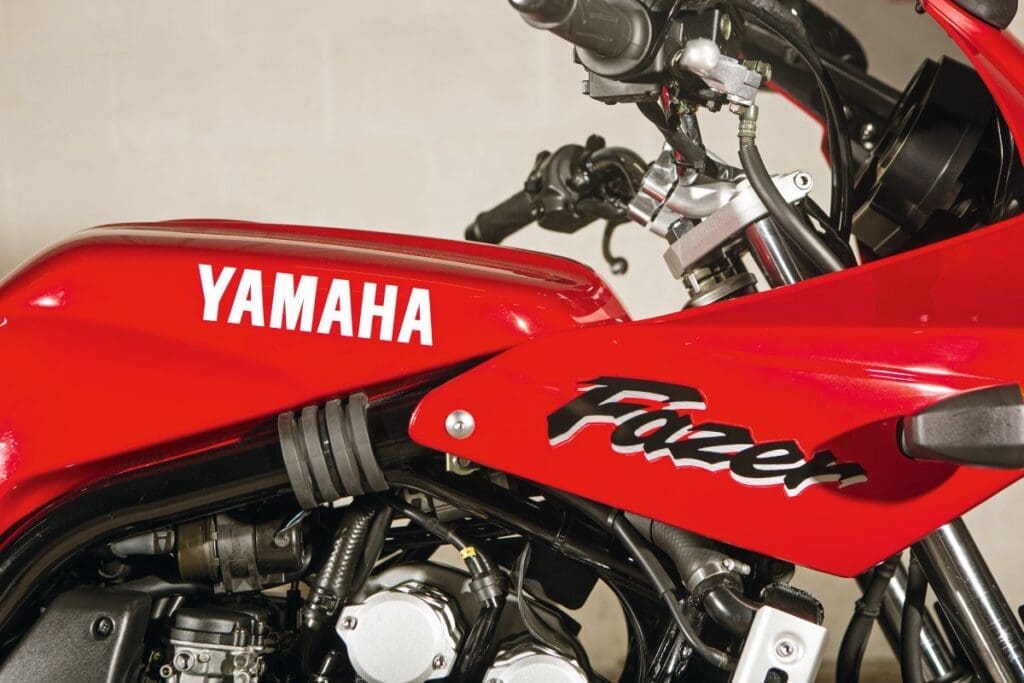
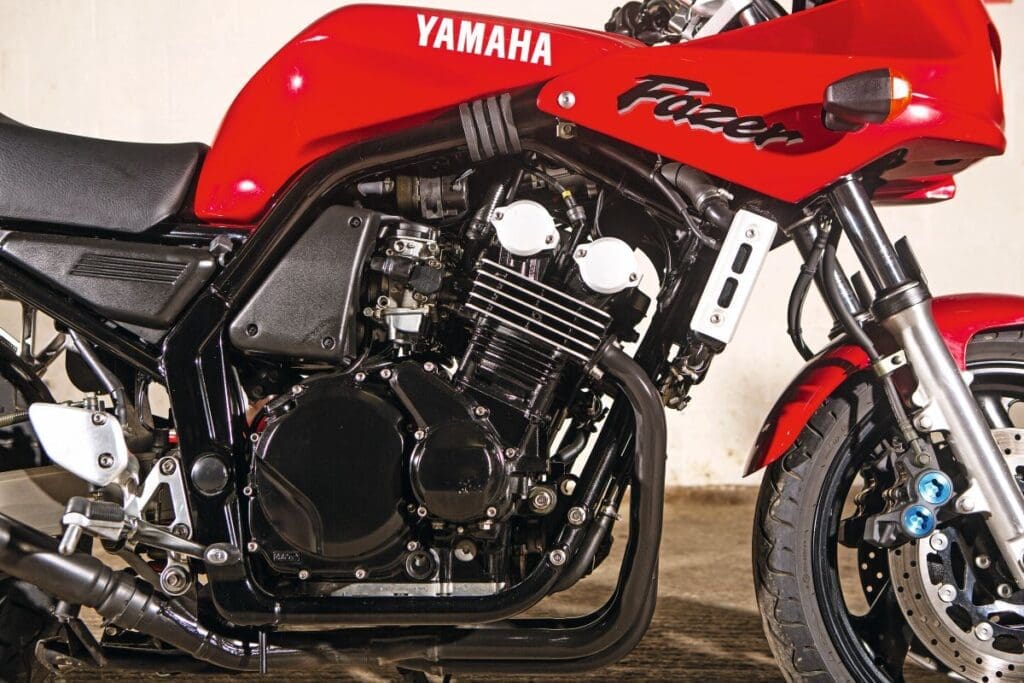
The chassis would be a cut above most other nakeds in the category, featuring the R1’s legendary Sumitomo ‘Blue-Spot’ brake calipers grasping twin 298mm discs and a slightly strange wheel/tyre combination of a 110/70-17 front and a 160/60- 17 at the rear.
The Fazer sat alongside (but above) the humdrum Divvy 6 at around £4950 OTR. This was spicier than both the-now £4500 Bandit and about £50
down on the (some would say) more classically attractive Honda Hornet.
But the Fazer outperformed everything else in the class. The power was a class-leading 95bhp at 11,500rpm, but it was the way it was provided to the rear wheel that was the joyous thing: it was smooth, linear and bump-free. Add into the mix that the bike was a deal more practical than the naked Hornet (Honda had to make a bikini-faired ‘S’ model to come close) and could do any manner of jobs you asked of it, and little wonder they soon became a best-seller.
Changes and upgrades were careful and considered as the competition in the class intensified. For 2000 the 5DM7 had an extra two litres of fuel (now 20), an updated LCD-style display with clock and two trips (original had one trip meter), and you still had a fuel gauge which most of the opposition still didn’t have. Better still, the 2000 model had pre-load adjustment on the 41mm forks – the rear was adjustable for that, too – and the S model came in a snazzy red with pin-stripes and gold with pin-stripes.
In 2002 the model was updated further with another two litres added to the tank and a redesign of the whole look of the bike (less boxy, more like
the Fazer thou’), as well as an updated cockpit. Many Fazer fans felt the original was best. Shockingly, for 2004 Yamaha replaced the Fazer
with the buzzy FZ6 which had a revvy, R6-based motor andnaff brakes, but the saving grace of better handling.
So why go for a Fazer today? Well, if you had one back in the 1990s it could be that nostalgia trip, but they still hold up as a good do-anything bike today. They handle well enough, are comfortable to ride for distance, and have a generous pillion provision – unlike most new naked bikes today. They’re also pretty simple to work on and superb value. So, what’s stopping you?

SUSPENSION
41mm forks got pre-load adjusters from 2000, but today front and rear will be soft – upgrades are plentiful. Fork leg lowers can suffer pitting/chipping. Swingarm linkages need greasing at service.
TYRES
110/70-17 front hoop means choice is limited.
EXHAUST
Down-pipes rot thanks to road crud hitting them; fender extenders useful. OE end-cans best, aftermarket ones often not rejetted for.
HEADLIGHTS
Can be poor at night but can be wired so BOTH lights come on. Not an issue on the 2002-03 model.
FRONT SPROCKET
Small nut can come off. Yamaha originally made a service note to replace it.
CHASSIS
Frame is a beautiful TZ copy but doesn’t have the thickest of paint: beware of rust.
BRAKES
Sumitomo Blue-Spots mean the Fazer 6 can be overbraked for newbies. They can lose performance unless cleaned regularly. Rear
caliper can seize thanks to being underslung.
CARBS
38mm Mikunis suffer old fuel badly. Ask if carbs have been jetted to suit aftermarket end-can.
ENGINE
Thundercat-derived mill is marvellous and issuefree. Coating on engine/ fins can fall off if not given TLC.
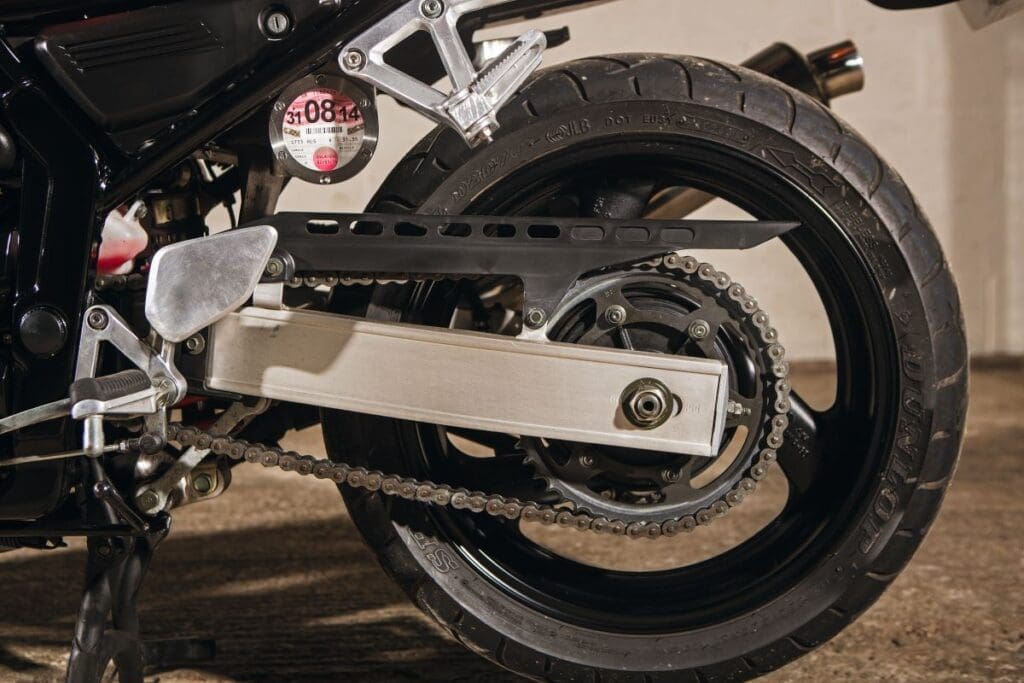
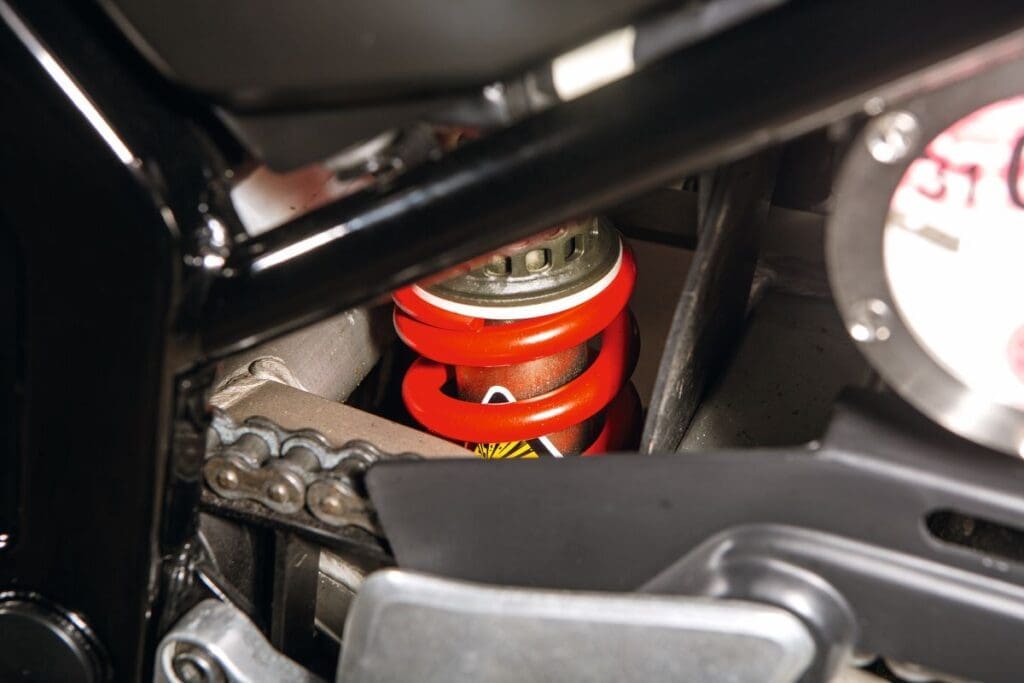
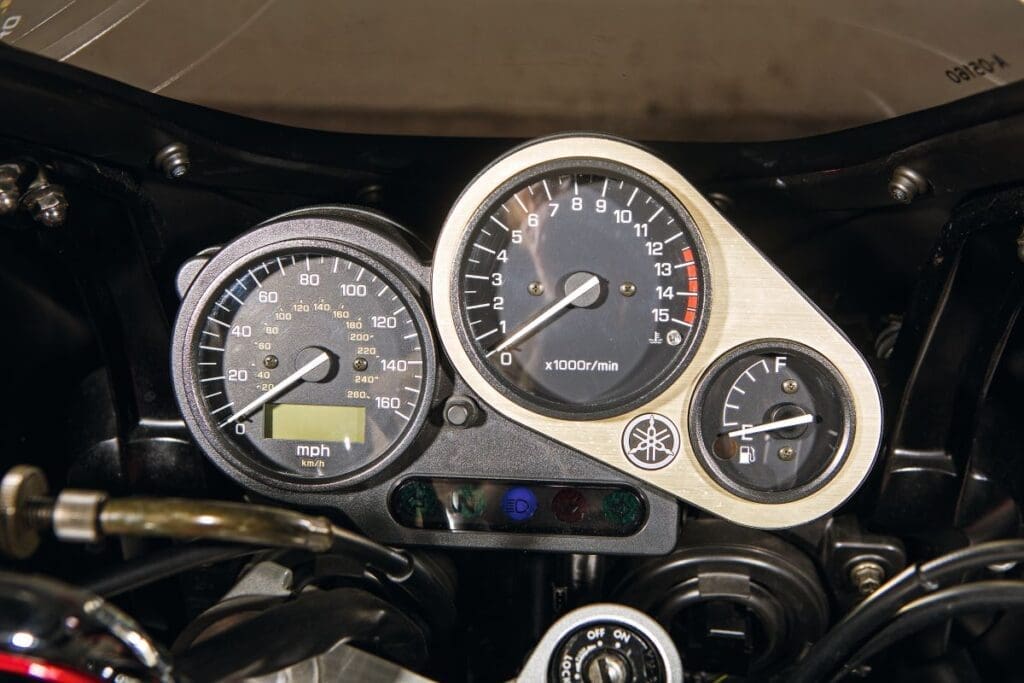
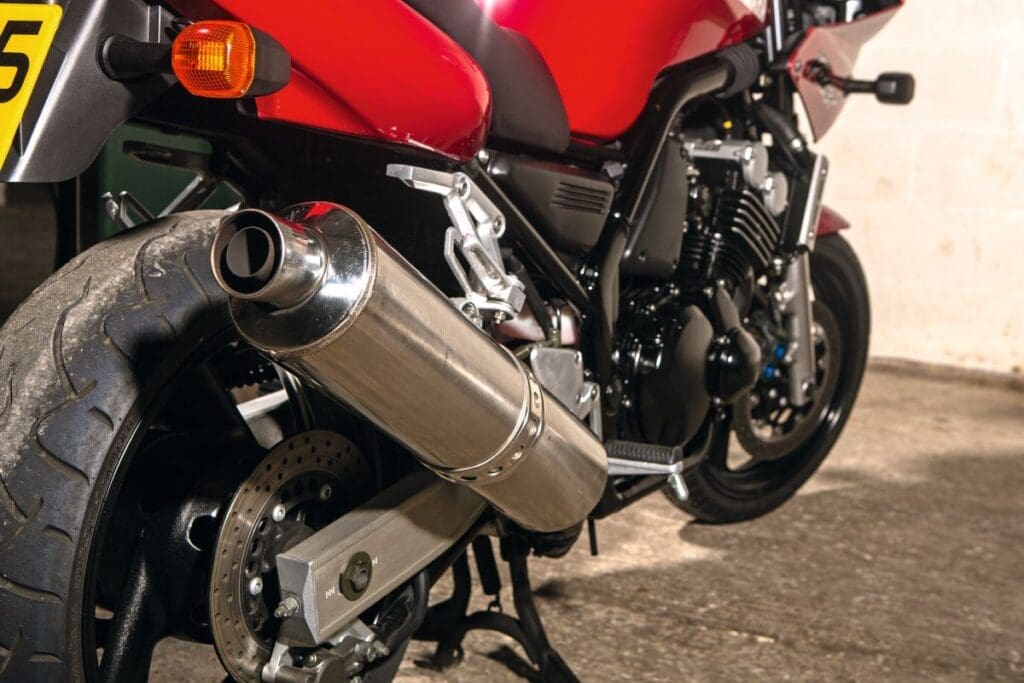
I owned one: Bertie Simmonds
When it came time for me to turn my back on the motorcycle industry and join Cosworth, I needed a bike that could do it all AND put a smile on my face. There could only be one bike…
It was the summer of 2000 and I was leaving my job as Bike magazine’s Road Test Editor for a desk-based PR job. It didn’t last… Having tested all the bikes of the previous five years or so, the choice was simple: the Fazer 600. I bought one new direct from Yamaha and used it for everything for about 18 months, until I got back into motorcycle journalism.
It was used for everything. I’d do the 35-mile commute there and back to Northampton every day for work. I’d go and enjoy Sunday breakfast runs, two-up days out with the lovely wife, and even a few track days.
In the end, the Fazer kept me in biking when I’d moved into the car world and pretty much reminded me daily of why I should get back into motorcycle journalism – which I did within a year! Today I still harbour designs on having a clean one as a general run-around as they really can do
everything well.
What to buy and how much to pay
Fazers were certainly ‘set to stun’ (groan) from launch back in the day. In fact, it became a best-seller and by the time the 2002 facelift model was on sale, around 82,000 Fazers had been sold in Europe alone.
Should be plenty around then? Yup, just not a lot of really nice ones as many were commuted on, used in London, dropped (they’re a great first bike), and generally abused. Some are the basis of some hideous ‘specials’ and/or cafe racers.
Clearly the last models are the best, with more tank range (some owners claimed the originals were a bit thirsty) and some would argue the better looks, but we’d disagree. We think the sweetest ones are 2000-2001 and while the ‘S’ models may see some sellers telling you they were ‘limited-edition’, the only difference was the paint and the £150 more on the original retail price.
Basket cases/projects start at £500, good ones with 30-50k on the clocks are a grand to £1500, with a low-mileage one still not much more than £2000. Bargain! Don’t forget that Café Racer Kits do a lovely looking TZ-a-like kit for the Fazer. Check out: https://www.caferacerkits.
co.uk
Specification
ENGINE TYPE
Liquid-cooled, four-stroke, four, 599cc
BORE AND STROKE
62.0 x 49.6mm
CLAIMED HORSEPOWER
95bhp @ 11,000rpm
MAXIMUM TORQUE
45.8ft/lb @ 9500rpm
TRANSMISSION TYPE
6-speed, chain final drive
COMPRESSION RATIO
12.0:1
CARBURETION
4 x 38mm Mikuni BDSR
TYRES
110/70-17(F), 160/60-17 (R)
FUEL CAPACITY
4.0 gallons (18 litres)
DRY WEIGHT
189kg (417lb)
WHEELBASE
1415mm (55.7in)
OVERALL LENGTH
2808mm (81.8in)
OVERALL WIDTH
710mm (28.0in)
HEIGHT
1180mm (46.6in)

